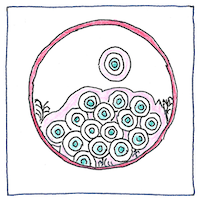Lazzaro Spallanzani
biology

|
Spontaneous generation
Maggots grow in cow pies. Tapeworms grow in intestines. Without knowing that flies and worms lay eggs and that stepping barefoot into feces or eating undercooked food can pick them up, people believed that very small creatures were generated spontaneously from decaying plant and animal matter. People like John Needham asserted that a vital principle inhered in such substances that spontaneously generated living things. Lazzaro Spallanzani tried to prove this, sterilizing his samples in sealed flasks, and failed. Realizing that heating and sealing his samples killed anything alive that was already in them and protected them from contamination, Spallanzani demonstrated the principle of pasteurization and scooped Louis Pasteur by ninety-five years.
Vital principle
Invisible parasites bacteria, viruses too small to see infect my body. I itch; I cannot help it; I become feverish; I grow hungry; I eat certain leaves and barks and I am cured. An idea occurs to me and I cannot get it out of my head. I try to test the idea and find that it violates a principle of nature. Living things inhabit everything in the air, land, and sea in rocks, in soil, in every drop of water. Obsesssed, I wash my hands although they are already clean and the water makes my fingers itch.
Miracles
Seems like miracles strangely inhabiting everything around us. Unidentified energies silently empower impossible creatures too numerous to count. Imagination generates reasons out of fears. Reason generates causes out of hopes. Surprise generates miracles when we can’t see the causes. We can’t explain these things. If this were pure luck, good or bad, it would be time to count our blessings.



Worms have been found in rocks at the bottom of a diamond mine; bacteria has been found deep in volcanic rock.
The theory of spontaneous generation originated with Aristotle, who wrote that the “vital heat” contained in air and water was responsible. Needham exposed his broths to air as they cooled after boiling (insufficiently to kill microbial endospores in the broths), not imagining that air could contain microbes and microbial endospores responsible for what he thought were generated spontaneously.
Apes and chimpanzees have been found to “self-medicate” by eating particular astringent leaves and inner barks to cure themselves of malaria and worms.
See also in The book of science:
Readings in wikipedia:
Other readings: